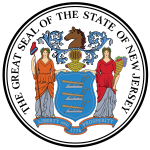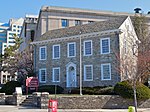French Arms Tavern
1730 establishments in New Jersey1837 disestablishments in New JerseyBuildings and structures demolished in 1837Buildings and structures in Trenton, New JerseyCommercial buildings completed in 1730 ... and 4 more
Former national capitol buildings in the United StatesHistory of Trenton, New JerseyNew Jersey in the American RevolutionTaverns in the American Revolution

The French Arms Tavern (also known as the Thirteen Stars, Blazing Star Tavern, City Tavern and City Hotel) was a structure in Trenton, New Jersey, that served as the capitol of the United States and meeting place of the Congress of the Confederation from November 1, 1784, to December 24, 1784. The building was located at the southwest corner of King (now Warren) and Second (now State) Streets from 1730 until 1837 when it was torn down.
Excerpt from the Wikipedia article French Arms Tavern (License: CC BY-SA 3.0, Authors, Images).French Arms Tavern
East State Street, Trenton
Geographical coordinates (GPS) Address Nearby Places Show on map
Geographical coordinates (GPS)
| Latitude | Longitude |
|---|---|
| N 40.2203 ° | E -74.7658 ° |
Address
Robert Lewis Store
East State Street 1
08608 Trenton
New Jersey, United States
Open on Google Maps






